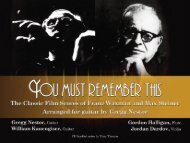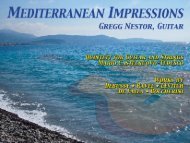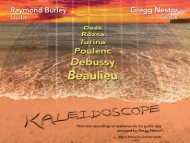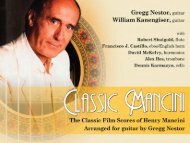Download Venezuela Alegre CD Full-Color Digital Booklet (PDF)
Download Venezuela Alegre CD Full-Color Digital Booklet (PDF)
Download Venezuela Alegre CD Full-Color Digital Booklet (PDF)
Create successful ePaper yourself
Turn your PDF publications into a flip-book with our unique Google optimized e-Paper software.
Album Produced by Gregg Nestor<br />
Recorded at Penguin Recording,<br />
Eagle Rock, CA. July 2010<br />
Engineer: John Strother<br />
<strong>Digital</strong>ly Mastered by Chris Doremus<br />
Album Art Direction: Mark Banning<br />
Mr. Nestor’s Guitar by luthier Ron Hachez,<br />
Courtesy of Jonathan Marcus<br />
www.guitarsbyronhachez.com<br />
Front Cover:<br />
Esteban Villaparedes<br />
www.villaparedes.com<br />
Special Thanks to:<br />
Victor Citrin<br />
Armando Baltra<br />
Oliver Eidam<br />
Nancy Atilano for Carlos' portrait<br />
Some of the pieces recorded in this album were published by<br />
Joachim-Trekel-Musikverlag, Hamburg, Germany.<br />
“Three <strong>Venezuela</strong>n Pieces” Catalog #T 6118<br />
“Three Pieces for Guitar” Catalog #T 6120<br />
“En Cumana” Catalog #T 6119<br />
“Suite de Antiguas Danzas” Catalog #T 6116<br />
“Calido Sur” published by Eres Edition, D-28859 Lilienthal/Bremen Germany<br />
Fingered and Edited by Oliver Eidam, Catalog #Eres-2977
Most of the classical guitar lovers in the world knew very little about<br />
<strong>Venezuela</strong>n guitar music until Andrés Segovia in the early 1950s<br />
recorded Antonio Lauro’s “<strong>Venezuela</strong>n Waltz No 3,” also called<br />
“Natalia.” The magic novelty inherent in the <strong>Venezuela</strong>n waltz comes from<br />
various sources. On the one hand it is a typical 3/4 waltz. However, at the same<br />
time it sustains a beautifully syncopated undercurrent beat that reminds us of<br />
African slave drums. This distinctive syncopation is created by a hemiola in<br />
which two measures of 3/4 become a single measure of 3/2. It’s as if the<br />
“criollo” generation (the mixing of European, African and native indigenous<br />
peoples) had given the European waltz a new face. Guitar lovers now make a<br />
clear distinction between “a waltz” and “a <strong>Venezuela</strong>n waltz.” Today the guitar<br />
world is not only aware of the music of Antonio Lauro, but also of a host of<br />
other composers who have been seminal in creating guitar music unmistakably<br />
<strong>Venezuela</strong>n. The grandfather of various generations of guitar composers in<br />
<strong>Venezuela</strong> is clearly Raul Borges (1882-1967), a renowned <strong>Venezuela</strong>n<br />
pedagogue, guitarist and composer. The second generation brings to mind,<br />
among others, Antonio Lauro, Alirio Diaz, and Antonio Ochoa who, in turn,<br />
influenced and educated a host of contemporary <strong>Venezuela</strong>n musicians.<br />
Carlos Atilano is a direct descendant of this historical line of musicians.<br />
Guitarist, composer and educator Carlos Atilano was born in Caracas,<br />
<strong>Venezuela</strong> on July 7th, 1952. Very early in his childhood he learned to play his<br />
national folk music on the “cuatro,” a small four course guitar from <strong>Venezuela</strong>.<br />
After almost completing his studies with Antonio Ochoa at the music<br />
conservatory in Caracas, he obtained a <strong>Venezuela</strong>n government scholarship to<br />
study at The Boston Conservatory of Music in Massachusetts, were he received<br />
his Bachelor of Music. He presently lives with his wife Nancy and his sons Carl<br />
and Thomas in Claremont, California where he teaches privately.<br />
Carlos Atilano’s guitar pieces almost invariably have their roots in the folklore of<br />
<strong>Venezuela</strong>. He proudly says: “All the pieces that I have written were inspired by<br />
pure love for my native land. Being away from <strong>Venezuela</strong> brings in me that<br />
nostalgia which comes from longing for my homeland, its music, its places and<br />
the aroma of the tropics.”<br />
The musical glory of the <strong>Venezuela</strong>n waltz is clearly demonstrated in Carlos’s<br />
compositions. The bass syncopation is effectively stressed in the “Valse” from<br />
“Three <strong>Venezuela</strong>n pieces.” “El Vals de Gregorio,” composed in 1991 and<br />
dedicated to guitarist Gregg Nestor, displays forceful accentuation and staccato<br />
effects in the melody. The hemiola effect, so characteristic of <strong>Venezuela</strong>n music,<br />
is well represented in “El Vals de Vladislav” dedicated to guitarist Vladislav<br />
Blaha from the Czech Republic, and also in “Vals Ingenuo,” first published in<br />
Classical Guitar magazine in 2008 and dedicated to Frederick Noad. “El Vals de
Villaparedes” was composed in honor of Carlos Atilano’s uncle and artist<br />
Esteban Villaparedes, who is the author of the painting featured in the cover of<br />
this <strong>CD</strong>. While all the previously mentioned waltzes are typically <strong>Venezuela</strong>n,<br />
“El Vals de Alirio” and “Vals de Adam y Eva” bring to mind feelings closer to<br />
the romantic European waltz tradition.<br />
With its African and European influences, the joropo is <strong>Venezuela</strong>’s national<br />
dance. It is also an excellent example of <strong>Venezuela</strong>’s “música criolla.” A<br />
traditional joropo band is normally composed of harp, cuatro, bandola (a pearshaped<br />
four course guitar) and maracas. The joropo displays enchanting<br />
polyrhythmic patterns by alternating 3/4 and 6/8 tempos. Carlos Atilano’s<br />
joropos, beautifully performed by Gregg Nestor, bring about the true essence of<br />
this dance. “Golpe Tuyero,” is a joropo from Valle del Tuy in the center of<br />
<strong>Venezuela</strong>. “Golpe de las Muchachas” was inspired by Keti and Boyana<br />
Stoyanova, two charming Bulgarian young twin sisters who formed a guitar<br />
duo. The “Pajarillo,” which begins with a “Tonada” theme, is the liveliest joropo<br />
of the three. The “Tonada y Pajarillo” was dedicated to Gregg Nestor. Finally<br />
“Aire Criollo” is not quite a joropo and not quite a <strong>Venezuela</strong>n waltz; rather it<br />
straddles the two musical genres since the listener can hear elements of both.<br />
From the viewpoint of rhythmic structure, the <strong>Venezuela</strong>n merengue, a very<br />
different dance from the 2/4 beat Dominican merengue, follows an intricate<br />
5/8 beat. This juxtaposition of 3 against 2, which provides its characteristic lilt,<br />
is a frequent pattern in most <strong>Venezuela</strong>n music. Atilano’s four merengues (“En<br />
Cumaná,” “Tia Petrica,” “Don Alejandro,” and “El Editor”) are good examples<br />
of this enticing rhythm. Cumaná is the capital of the <strong>Venezuela</strong>n State of<br />
Sucre. “Tia Petrica” was composed as an homage to his aunt Petrica Milano<br />
who livened Carlos’s childhood and family gatherings with her joyous spirit and<br />
dancing. While “Don Alejandro” is dedicated to the <strong>Venezuela</strong>n musicologist<br />
Alejandro Bruzual, “El Editor” is dedicated to Colin Cooper, the editor of<br />
Classical Guitar magazine.<br />
The four pieces in the “Suite del Sur” are inspired in Argentinian musical<br />
genres. “Calido Sur,” dedicated to German guitarist Oliver Eidam, opens with a<br />
prelude which slowly hints a tango and then gradually turns into a mournful<br />
and poetic “milonga campera,” which is normally used to accompany sorrowful<br />
poems. While “Querida Soledad,” dedicated to Polish guitarist Krzysztof<br />
Meisinger, brings all the classic features of a tango, “Mi Querida Andina” is an<br />
Argentinian bahuala (i.e., a slow highly expressive lament). Finally the last piece<br />
in the suite, “Milonga Giocosa,” is a lively and fast-paced dancing milonga<br />
dedicated to Bernard Hebb, guitar professor at The University of The Arts in<br />
Bremen.<br />
This collection contains two serenades. “Lamento” is dedicated to Rodrigo<br />
Riera, one of the most prominent guitarist in <strong>Venezuela</strong>, and “Cancion,” was<br />
composed in honor of Antonio Ochoa, Carlos’s first guitar teacher. “Entre tu<br />
Olvido,” “En tu Lejanía,” and “Atardecer en Caracas” are slow sentimental<br />
melodies which exemplify Carlos’s longing for his homeland and nostalgic<br />
feelings for places and time past. Aguinaldos are melodies sung during<br />
Christmas in <strong>Venezuela</strong>. When Carlos composed “Aguinaldo Caraqueño,” he<br />
was inspired by a memory of his childhood when he saw a joyous group of<br />
small children singing aguinaldos on a Caracas TV program. It was dedicated<br />
to the well known guitar virtuoso and music professor Eliot Fisk.<br />
Though Carlos Atilano has made many guitar arrangements of famous<br />
melodies, only one of those is included in this collection. “Como llora una<br />
estrella” is an extremely popular <strong>Venezuela</strong>n song composed by mandolin player<br />
Antonio Carrillo in 1915.<br />
Como Llora una Estrella<br />
Recuerdos de un ayer que fue pasión,<br />
del suave titilar que ayer yo vi,<br />
de tu dulce mirar tu amor sentí,<br />
tu cara angelical, rosa de abril.<br />
Como quisiera yo amar y ser<br />
la mística oración que hay en ti;<br />
pero al no sentir tu raro amor de ayer<br />
tu estrella solitaria llorará de amor.<br />
Dame la tierna luz que tiene tu mirar,<br />
que es como el titilar de una estrella de amor;<br />
y en éxtasis profundo de pasión<br />
mis versos tristes yo te brindaré;<br />
y en tu lozana frente colgaré<br />
la estrella de este gran amor.<br />
The Crying of a Star<br />
Memories of a fervent yesterday,<br />
of the soft twinkling that yesterday I saw<br />
of your sweet gaze, your love I felt,<br />
your angelical face, April rose.<br />
How would I like to love and be<br />
the mystic prayer that is in you!<br />
But not feeling your unique love of yesterday<br />
your lonely star will cry of love.<br />
Give me the tender light of your gaze,<br />
which is like the twinkle of a love star<br />
and in a profound ecstasy of passion<br />
I will offer you my sad verses<br />
and on your youthful forehead I’ll place<br />
the star of this immense love.
It might seem strange to have a suite of baroque dances in a <strong>CD</strong> entitled<br />
“<strong>Venezuela</strong> <strong>Alegre</strong>.” However, they are included here because these pieces are<br />
particularly dear to Carlos since they were a turning point in his life. The “Suite<br />
de Antiguas Danzas” was composed during a very difficult time while he was<br />
studying music in Boston. An accidental injury prevented him from playing guitar<br />
for many years. But then Carlos tells that …. “one night in 1982 this music came<br />
to me as if I had already played it in another life. This may sound crazy, but I felt<br />
as if I had once been a 18th century lutenist somewhere in Europe.” The quality<br />
of these compositions was such that they were officially approved for<br />
performance by the head of the composition department, Christopher Roze.<br />
Encouraged by the acceptance of his “Danzas,” he went on to revise some<br />
<strong>Venezuela</strong>n pieces he had composed back home. They were all equally received<br />
with great enthusiasm at the Boston Conservatory. This sudden burst of success<br />
effectively became the springboard to his composing career. The “Suite de<br />
Antiguas Danzas” was dedicated to Christopher Parkening, one of Segovia’s most<br />
famous students.<br />
Armando Baltra (Ph.D.)<br />
Internationally acclaimed guitarist Gregg Nestor has built a strong<br />
following for his abilities as soloist, accompanist and arranger.<br />
Finalist in the 1981 New York Concert Guild Competition held at<br />
Carnegie Hall, Gregg has recorded and broadcast in Holland,<br />
Belgium, Spain and for the BBC in London. In his London debut,<br />
The Times critic commented on his being “uncommonly<br />
communicative, a real artist in timing and shading, in stylish fluency<br />
and tact besides wholehearted communication with his composers.”<br />
Many works arranged by Gregg Nestor for solo/duo guitars or with<br />
various ensemble have been published. In 1986 Gregg was the<br />
recipient of the Sonata for Guitar, Op 42 by Hungarian concert and<br />
film composer Miklós Rózsa, published by Associated Music (G.<br />
Schirmer). It is recognized as one of the landmarks of 20th century<br />
literature for the guitar.
<strong>Venezuela</strong> <strong>Alegre</strong>: The music of Carlos Atilano<br />
THREE VENEZUELAN PIECES<br />
1. Aire Criollo 1:26<br />
2. Canción 2:00<br />
3. Valse 1:51<br />
4. Tía Petríca 2:08<br />
THREE PIECES FOR GUITAR<br />
5. El Vals de Alirio 2:58<br />
6. Lamento (Bolero) 4:41<br />
7. El Vals de Villaparedes 2:00<br />
8. El Editor 1:31<br />
9. Atardecer en Caracas 1:53<br />
TRIPTICO<br />
10. En Cumaná 1:37<br />
11. Aguinaldo Caraqueño 1:33<br />
12. El Vals de Gregorio 1:47<br />
13. Golpe Tuyero 2:03<br />
SUITE DE ANTIGUAS DANZAS<br />
14. Prelude 1:50<br />
15. Allemande 2:16<br />
16. Courante 2:32<br />
Gregg Nestor, guitar<br />
2013 Gregg Nestor. All Rights Reserved.<br />
Released by BSX Records, A Division of BuySoundtrax.com • 2828 Cochran Street #287, Simi Valley, California 93065<br />
17. Sarabande 2:18<br />
18. Minuet 2:41<br />
19. Gigue 2:35<br />
20. Como Llora una Estrella 2:49<br />
(composed Antonio Carrillo, arr. Carlos Atilano)<br />
SUITE DEL SUR<br />
21. Cálido Sur 6:00<br />
22. Querida Soledad 3:44<br />
23. Mi Querida Andina 3:04<br />
24. Milonga Giocosa 2:48<br />
25. Entre tu Olvido 3:01<br />
TRES VALSES VENEZOLANOS<br />
26. Valse Ingénuo 2:00<br />
27. Vals de Adam y Eva 3:03<br />
28. El Vals de Vladislav 1:52<br />
VENEZUELA ALEGRE<br />
29. Don Alejandro 1:40<br />
30. El Golpe de Las Muchachas 1:27<br />
31. En tu lejanía 2:50<br />
32. Tonada y Pajarillo 3:12<br />
Total Time: 79:18







